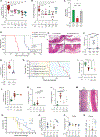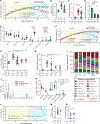Opposing diet, microbiome, and metabolite mechanisms regulate inflammatory bowel disease in a genetically susceptible host
- PMID: 38513656
- PMCID: PMC11064055
- DOI: 10.1016/j.chom.2024.03.001
Opposing diet, microbiome, and metabolite mechanisms regulate inflammatory bowel disease in a genetically susceptible host
Abstract
Inflammatory bowel diseases (IBDs) are chronic conditions characterized by periods of spontaneous intestinal inflammation and are increasing in industrialized populations. Combined with host genetics, diet and gut bacteria are thought to contribute prominently to IBDs, but mechanisms are still emerging. In mice lacking the IBD-associated cytokine, interleukin-10, we show that a fiber-deprived gut microbiota promotes the deterioration of colonic mucus, leading to lethal colitis. Inflammation starts with the expansion of natural killer cells and altered immunoglobulin-A coating of some bacteria. Lethal colitis is then driven by Th1 immune responses to increased activities of mucin-degrading bacteria that cause inflammation first in regions with thinner mucus. A fiber-free exclusive enteral nutrition diet also induces mucus erosion but inhibits inflammation by simultaneously increasing an anti-inflammatory bacterial metabolite, isobutyrate. Our findings underscore the importance of focusing on microbial functions-not taxa-contributing to IBDs and that some diet-mediated functions can oppose those that promote disease.
Keywords: dietary fiber; inflammatory bowel disease; microbiome; mucus.
Copyright © 2024 The Authors. Published by Elsevier Inc. All rights reserved.
Conflict of interest statement
Declaration of interests E.C.M. works as a consultant and an advisory board member at January, Inc., United States. M.S.D. works as a consultant and an advisory board member at Theralution GmbH, Germany.
Figures






References
-
- Mirkov MU, Verstockt B & Cleynen I (2017).Genetics of inflammatory bowel disease: beyond NOD2. Lancet Gastroenterol. Hepatol. 2, 224–234. - PubMed
-
- Maloy KJ & Powrie F (2011). Intestinal homeostasis and its breakdown in inflammatory bowel disease. Nature 474, 298–306. - PubMed
-
- Ng SC et al. (2017). Worldwide incidence and prevalence of inflammatory bowel disease in the 21st century: a systematic review of population-based studies. Lancet 390, 2769–2778. - PubMed
-
- Agrawal M, Burisch J, Colombel JF & S CS (2020). Viewpoint: Inflammatory Bowel Diseases Among Immigrants From Low- to High-Incidence Countries: Opportunities and Considerations. J. of Crohn's & colitis 14, 267–273. - PubMed
MeSH terms
Grants and funding
LinkOut - more resources
Full Text Sources
Molecular Biology Databases

